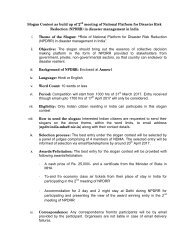National Disaster Management Guidelines School Safety Policy
School-Safety-Policy
School-Safety-Policy
You also want an ePaper? Increase the reach of your titles
YUMPU automatically turns print PDFs into web optimized ePapers that Google loves.
SCHOOL <strong>Safety</strong><br />
POLICY <strong>Guidelines</strong><br />
Executive Summary<br />
The <strong>National</strong> <strong>School</strong> <strong>Safety</strong> <strong>Policy</strong> <strong>Guidelines</strong> stand for a vision of India where all children and their<br />
teachers, and other stakeholders in the school community are safe from any kind of risks due to<br />
natural hazards. The <strong>Guidelines</strong> focus upon the urgent need to strengthen risk resilience of schools<br />
in rural as well as urban areas of the country. It is hoped that this document will be useful to ensure<br />
that all school children across the country remain safe from any kind of disaster risk as they access<br />
their right to education.<br />
The <strong>Guidelines</strong> highlight upon the following key elements:<br />
●<br />
●<br />
●<br />
●<br />
●<br />
Addresses the vertical of school safety in a more inclusive and holistic manner in the<br />
national policy sphere<br />
Capacity building of children, teachers, school personnel, state and district education<br />
machinery on school safety and disaster preparedness<br />
Anchoring /implementing child centered community based disaster risk reduction in<br />
the local context<br />
Mainstreaming risk and safety education in the school curriculum.<br />
Linking school safety in the existing government schemes and policies.<br />
● Strengthening coordination amongst institutional structures at the district, state, and<br />
national levels to promote effective child rights governance in disaster situations<br />
Chapter 1 introduces the concept and examines the importance on school safety as placed<br />
in the various national policies and guidelines.<br />
Chapter 2 details the key challenges faced while addressing safety issues in schools, the<br />
core principles of school safety which have been kept in mind while formulating the said guidelines<br />
and the vision and objectives of the guidelines.<br />
Chapter 3 details the various activities that need to be undertaken at the state, district<br />
and local levels to be able to address school safety in a holistic manner. This includes, school safety<br />
planning at designated levels, preparation of school disaster management plans, implementation<br />
of safety actions (structural and non –structural measures, capacity building of stakeholders,<br />
incorporation of school safety and disaster preparedness in core curriculum, monitoring of risk and<br />
mainstreaming of disaster risk reduction in all the school education initiatives.<br />
Chapter 4 details the roles and responsibilities of the various stakeholders to ensure<br />
school safety at national, state and local levels.<br />
Chapter 5 highlights specific actions towards school safety that can be undertaken by<br />
different stakeholders within the existing framework for delivery of education.<br />
ix



